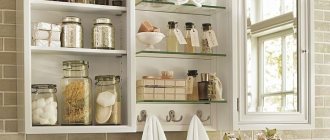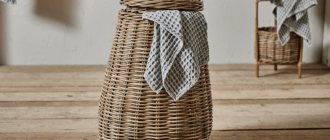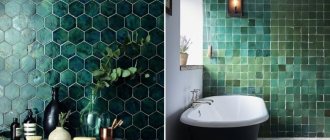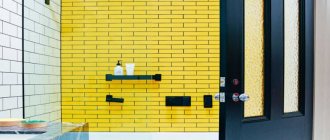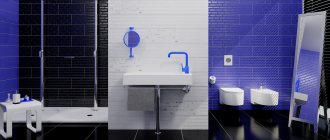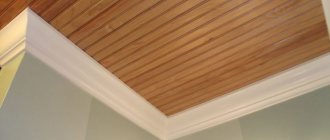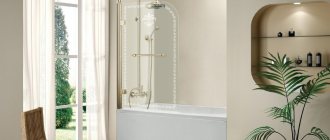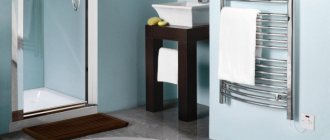section: Curtains photo / Curtains in the bathroom Just half a century ago, when multi-storey buildings began to be erected en masse (in order to satisfy the housing needs of the working population), importance was attached exclusively to the speed of construction of the building. We weren't even talking about comfort. All rooms in the apartments met the minimum requirements for living space, and therefore had modest dimensions, low ceilings, and small windows.
The situation was especially critical with bathrooms, occupying an area of 2 to 4 square meters. Such rooms were closed boxes, since they did not even have windows. But over time, the architects realized their mistakes and are now working hard to improve the comfort of housing. Modern bathrooms already have large sizes and even windows, like the rest of the rooms in the apartment/house.
Having a window in the bathroom: what are the advantages?
A window in a room is primarily a source of light. With natural light, the bathroom looks larger and more spacious, and the feeling of a damp, damp room disappears. The window can be used to ventilate the room. By opening it, you will quickly get rid of excess moisture or unpleasant odor in the bathroom. Fresh air will help you invigorate in the morning, and the sun's rays will make taking a bath more enjoyable.
A window in the bathroom is good, you might think. — What about the confidentiality of the premises? On the modern market of interior goods there are various types of curtains that can solve this problem. They will ensure the confidentiality of what is happening in the room, hiding it from view from the street, make the bathroom more comfortable, fill it with sunlight, soften sounds, and eliminate echoes.
Features of selecting window frames for the bathroom
Deciding on the model
The design of curtains for the bathroom is selected taking into account the size of the room and the style of its design. To frame a window in a small hygienic room, compact canvases corresponding to the size of the opening are suitable. They will not take up much space and will allow you to effectively use the window space.
In large bathrooms, curtains of various designs can be used. In this case, the choice of a suitable model is made based on the style of the room. And it can be different: from minimalism to palace classics, or high-tech hi-tech.
Selecting the type and color of fabric
Since the bathroom is a room characterized by high humidity and temperature changes, it is necessary that the window frame be resistant to these phenomena. For sewing curtains, both synthetic and natural fabrics treated with moisture-proof impregnation can be used.
Using special solutions, curtains are given antistatic, dust-repellent properties, and resistance to fading in the sun. Fabrics treated with impregnation become stronger, last a long time, and respond well to frequent washing.
To combine the window design with the interior of the room into one composition, the same colors and patterns are used. Therefore, the colors of the curtains should contain tones or motifs found on tiles, mirrors, and bathroom furniture.
Advice: it is better to choose a curtain rod from the material used in the interior - plastic, metal, wood.
Control mechanism
All functional curtains that open/close the window can be controlled either manually or automatically. To do this, they are equipped with an electric drive, which is activated by a remote control.
Bottom line: when choosing curtains for the bathroom, you should choose moisture- and heat-resistant models that are easy to maintain and have a convenient control system.
Why do you need glass bath screens?
The enclosure of a bath or shower carries a double functional load - protective and aesthetic. A curtain installed with the bathroom will protect the surrounding space from water if materials and equipment that are not susceptible to splashes are used in the decoration and furnishings of the room. This could be rugs, wood panels or a washing machine. Even if the interior contains only moisture-resistant materials, splashes of water will leave noticeable stains on their surface. And wiping the water off the floor every time after taking a bath is also not a pleasant task.
A bathtub with a curtain creates a certain zoning of the room, and the transparent glass surface of the screen gives a feeling of expanded space, which transforms small bathrooms and introduces an element of organization into the interior.
The advantages of such a protective fence are:
- ease and simplicity of installation;
- high environmental friendliness of materials;
- resistance against the formation of fungus and mold;
- lack of tendency to cloudiness;
- resistance against chemically active substances, which facilitates the use of detergents to care for the curtain structure;
- resistance to mechanical stress;
- durability.
Using blinds in the bathroom
Blinds are window structures consisting of movable horizontal or vertical plates (slats) fastened together with threads. They are made of plastic, aluminum, fabric, wood. The lamellas can move up and down and also rotate around their axis.
The most common are horizontal blinds. They can be additionally equipped with special guides that allow you to support the canvas in the plane of the inclined window. When installed in openings of non-standard shapes, the slats rise only to the point of maximum width.
Vertical blinds can be installed on windows of any configuration (arched, rectangular, triangular, trapezoidal). Their slats are made of fabric 89-127 mm wide, treated with special impregnations that increase the performance properties of the product.
These blinds can be moved apart from the middle, or moved to one side, which allows you to control the lighting of the room. And the use of fabric of different colors, textures, and degrees of transparency will allow you to experiment with the design of the product.
The main advantages of blinds are practicality and low cost. Therefore, they are often used to decorate windows in bathrooms. The advantages of using them in these premises:
- Compactness;
- Ease of management;
- Combination with tiles and other finishing materials.
Tip: if you associate blinds with an office, complement them with fabric curtains.
Window curtains
Most often in multi-storey buildings there are no windows in the bathroom, but in private sectors small windows are very common. The window performs many functions: ventilation, so mold does not form. The window is an excellent addition to artificial lighting, in addition, the room seems spacious and bright.
Blinds are often used to decorate windows. This design option does not require large financial expenditures and looks original. Also, owners of private sectors respect roller blinds. They look great on small windows in small spaces.
Decorating a window in a bathroom with roll structures
Roller blinds are a flat curtain that is raised by winding on a shaft. When folded, the product is compactly located at the top of the window. The design can be:
- Open - when the shaft with the fabric is visible;
- Closed - the winding shaft is disguised by a decorative box.
The canvases are made from materials of different colors, textures and degrees of transparency, which allows you to adjust the lighting of the room. 100% protection from light will be provided by the use of BLACKOUT fabric, which completely blocks the sun's rays.
Roller blinds are installed on regular and inclined windows, but only in rectangular shapes. They can be used independently or in combination with other curtains.
Note: rolled canvases with patterns or a pronounced texture look very impressive, as they resemble artistic canvases.
The use of Roman linens in the bathroom
This is a lifting type of curtain, the panel of which, when lifted, forms uniform horizontal falling folds. Modern, improved models are equipped with a movable upper and lower profile, which allows you to open the necessary part of the window.
The abundance of colors allows the product to harmoniously fit into bathrooms of various designs.
These curtains can be installed on horizontal and vertical openings. The model is easy to operate, so it is suitable for framing tall windows that are difficult to reach.
Please note: when installing Roman curtains on structures of complex shape, the curtain can only rise to the level of the bevel.
A practical and functional version of Roman blinds for the bathroom is the “day-night” model. The design consists of two curtains (transparent and thick), located one on top of the other. The lighting in the room is adjusted by closing the required curtain. A model equipped with upper and lower guides will allow you to open the desired part of the glass unit.
Recommendations for selection
When choosing a curtain for the bathroom, you need to consider:
- its dimensions;
- appearance;
- material of manufacture;
- fastening type.
Taking these characteristics as a guide will help you choose a model that will be pleasing to the eyes and will last for decades.
Framing bathroom windows with pleated curtains
A pleated curtain is a lifting curtain whose panel forms an accordion. The fabric is fixed on a thin profile cornice. Its lower edge is held in place by a weight bar. The folding/unfolding of the canvas is regulated by threads running along its edges.
When open, the curtains cover the entire opening/sash, and when closed they are compressed into a compact 4-5 centimeter briquette. We accept the option of partially opening the pleated section (using the upper and/or lower profile) and fixing it at the required height. The curtain fabric can be of different densities and even consist of two parts that differ in color and degree of transparency. These characteristics allow you to experiment with lighting and room design.
Pleated curtains can be installed on standard windows (horizontal, vertical), as well as beveled and round ones, without losing their functionality. This allows them to be used to decorate bathrooms located in the attic. These canvases can be either plain or printed. They combine well with other types of fabric curtains.
Japanese curtains in the bathroom
These curtains are flat fabric sheets fixed with two profiles. The window structure consists of several sections that move along the cornice on special guides. The width of the canvas varies from 40 to 80cm, the length can be different. Japanese curtains are made from materials of different densities and colors, which allows you to quickly change not only the lighting, but also the design of the room.
Note: the length of the canvas cannot be changed. Adjustment of the intensity of light entering the room is carried out by moving the sections left and right along the cornice.
Japanese panels are best suited for minimalist interiors. They look good in spacious bathrooms with French windows.
Decorating a bathroom with classic curtains
This window composition consists of curtains and sliding curtains. This set makes the room more cozy, so it looks good in a large space. The cost of classic curtains is influenced by the sewing material, its quantity, and the complexity of the product design.
In small bathrooms, where it is not possible to curtain the windows with drapes and curtains, you can use classic models consisting of one sheet. Austrian, French and English canvases do not take up much space, but, thanks to their exquisite folds, they look amazing. Depending on the type and color of the fabric, they will suit both an elegant classic interior and a simpler, unpretentious, but cute Provence.
Preparation before choosing curtains
Buying curtains for the bathroom is not difficult. But before you make a final decision, you should understand some issues:
- functionality of curtains,
- purchase price,
- interior style and frequency of its change.
You can get complete answers using our article, which will help you learn about the types of curtains, the materials used and configurations, properties and characteristics.
Other ways to decorate a bathroom window
If the opening in the bathroom is located close to the ceiling, you can curtain it with light tulle made of translucent fabric, secured with an effective tie on the cornice, or curtain holders.
Note: such a frame will emphasize the unusual shape of the round opening, for which it is difficult to choose a suitable curtain.
Curtains with eyelets are stylish and practical. This window design option can also be used in the bathroom. The canvases can be short or long, straight, or gathered with cords - it all depends on how much light needs to be let into the room and the design of the bathroom.
Advice: if there is often high humidity in the bathroom, it is better to use plastic rather than metal eyelets to attach curtains - they will not oxidize over time.
Blackout curtains for bathroom privacy
Modern interior design is aimed at providing maximum comfort to the inhabitants of a house or apartment. Blackout curtains were invented for this purpose. Among their advantages:
- Effective protection of premises from viewing from the street, sunlight (the opacity and light resistance of the material is 100%);
- Additional heat and sound insulation of the window structure;
- Decorative effect - these curtains can be of different designs and colors.
Advice: such paintings should be purchased by people living on the lower floors of apartment buildings or in roadside cottages.
Bathroom curtains
A bathroom is a room in which you cannot do without water. Even if you finish all the surfaces with moisture-resistant materials, the floor will still be wet after taking a shower or bath. For these purposes, special curtains and protective structures are provided. They are made from fabric, plastic, glass and even polyethylene. Let's look at their main varieties.
Fabric curtains for the bathroom: what are their advantages
At first glance, the choice of textile material for splash protection looks strange. But modern materials are adapted to conditions of high humidity - they are treated with special impregnations. The main advantages of this accessory:
- Variety of designs. The fabrics for sewing them differ in texture and color, which allows you to adapt them to the design of the room;
- Acceptable price . Compared to protective screens and glass, a fabric curtain will cost much less with similar functionality;
- Functionality. The polyester and cotton that make up the curtain have a moisture-repellent coating, so they do not get wet. The fabric is pleasant to the touch, soft, and does not stick to the body during bathing;
- Easy to care for . To remove dirt and maintain the accessory in normal sanitary condition, it can be washed by hand or in a washing machine. The product dries directly on the bar. The washing mode is indicated on the tag.
For the manufacture of protective curtains for the bathroom, the following is used:
- Polyester is a certified artificial material that meets all environmental and sanitary standards. It has high strength, vapor permeability, resistance to acids and alkalis;
- Cotton. 100% natural material is treated with a moisture-proofing agent, so it does not absorb water or dirt;
- Cotton/polyester blend . The fibers are mixed in different proportions to create a material ideal for use in the bathroom. Their practicality is ensured by additional moisture-proof impregnation.
Textile curtains differ:
- Method of fastening;
- Shape of the bar.
The protective sheet for the bathroom can be attached to rings (with or without hooks), eyelets, magnetic clips, chains, or placed directly on the bar. The most common type of fastening is when the fabric is hung on a cornice using rings made of plastic or metal. With this method of fixation, the curtain can move quickly and unhindered.
Note: a flexible cord can run along the bottom edge of the curtain, which makes the material heavier and prevents it from bunching up and clinging to plumbing fixtures.
Most often, the protective sheet for the bathroom is attached to a round rod. Sometimes ceiling cornices can be used, on which the curtain is hung using chains and hooks. The wall rod is:
- Direct - located between opposite walls in the bathroom;
- Curved - repeats the non-standard shape of the bathing tank.
Tip: the curtain rod must be installed so that the curtain fits snugly against the wall, preventing splashes on the walls and floor.
Fabric curtains
Fabric curtains, or curtains in other words, are a good solution for the bathroom. They are attached to the bar using rings or hooks. Fabric products are made from polyester - the fabric has a waterproof treatment.
Curtains can have a smooth or textured texture; satin, linen and cotton are very popular.
We also recommend:
- Black bathroom - photo of how to create a stylish dark-colored bathroom design
Corner bathroom: photo review, advantages, types and characteristics
- Bathroom color - photo ideas and expert advice when choosing a color for the bathroom
Polyester does not change color or shape after washing and is resistant to temperature changes.
The only disadvantage of fabric curtains is the formation of fungus. To avoid this, take care of the ventilation of the bathroom.
Features of choosing protective curtains for a corner bath
Recently, in the design of bathroom interiors, there has been a tendency to use original forms. Corner or teardrop-shaped bathtubs look more impressive than standard ones and take up less space. But they also need to be protected from the rest of the space so that splashes of water do not fall on the walls, floor, or furniture.
When selecting a curtain and a rod for attaching it, the shape of the tank is taken into account.
The most common types of curtain rods for non-standard baths:
- Arc;
- L-shaped.
Curtains for such bathtubs are selected according to the following criteria:
- Material of manufacture . The product must be durable, wear-resistant, not deformed when exposed to moisture, and made from a safe material;
- Optimal size . A narrow curtain will not be functional because it will not protect the room from splashes. Too wide or long canvases get tangled and take up a lot of space. Before purchasing a protective curtain, it is better to take measurements of the bathroom to select a product of the appropriate size;
- Mounting method . It can be universal, wall or ceiling. Correctly selected fastening increases the functionality of the product;
- The degree of transparency of the material . If there is a lack of natural light in the bathroom, it is better to use a light-colored curtain. If there is no need to ensure confidentiality when adopting procedures, they can be transparent;
- Compliance with the design of the room . No matter how practical and reliable a bathroom curtain is, it will look ridiculous if it is not matched to the overall style of the interior. The color of the product should match the color scheme of the room, or be neutral.
Variety of materials
When choosing curtains for a bathroom window, another important parameter is taken into account - the type of fabric material.
All possible options are divided into groups:
- polymer;
- wooden;
- woven.
When choosing curtains for a bathroom, the following parameters are taken into account:
- material density: determine how well the product holds its shape;
- strength;
- wear resistance;
- moisture resistance;
- safety of composition and design during operation.
The material must match the style of the room. For example, simple polymer curtains are not suitable for a classic bathroom interior. Polycarbonate is stronger, but it is also not used when arranging rooms with an expensive design. Wooden shutters may not be used in all interiors.
Soft silicone for window
The products are safe to use, do not emit toxic substances when heated (under the influence of hot steam), and last a long time. If the window is located next to the bathtub, there may be splash marks on the surface, which is especially visible on transparent material.
However, contaminants are quickly removed. It is easy to care for such curtains, but they cannot be used in all interiors. For example, they are not suitable for the classic style, as well as for the loft, Provence and rustic options.
Wood and glass shutters
If you need to decorate a window in an apartment, choose the method of opening the shutters into the room. In a private house, it is possible to use a method in which these elements move outward.
However, to improve convenience, you should still return to the first option. In addition, the area of the bathroom is taken into account - if it is large, choose any method. For small rooms, opening outwards is suitable.
Use wooden blinds or glass equivalents. Moreover, in the first case, the lamellas can be rotary or not. Glass shutters are used as decoration. They are made of impact-resistant material and do not contain rotating parts.
Semi-rigid Teflon
Curtains are produced using a special technology of weaving threads. The finished canvas does not absorb water. Drops hitting the surface roll off. There are no marks left, because the material is smooth on the outside.
This saves the effort of cleaning the surface every time you take a bath or shower. Teflon products are used to decorate a window that is located in close proximity to the bathtub - in this case, many drops fall on the glass. A canvas with a protective coating is chosen taking into account the design features of the room.
Polyethylene and polycarbonate
Polymer-based materials differ in structure and composition, which determines the service life of each of them. The intensity of use also influences. For example, a product made of polyethylene is short-lived.
Polycarbonate is a durable material. It will withstand daily wear and tear without showing signs of wear. Polycarbonate is easy to clean. To reduce the light transmittance of the product, you should choose a matte material.
As a result, the view from the street will be reduced, and light pollution will not be visible. But polymer materials will not withstand significant mechanical load.
Vinyl curtains
Another name is polyvinyl chloride. Lasts a long time. Although it is not very resistant to mechanical damage, it does not lose its attractiveness and shape over a long period. Dirt is quickly removed from vinyl material, but it also gets dirty easily.
The disadvantage is the ability to absorb odors. In addition, these curtains are simple in appearance; it is better not to use them to decorate the window of a room with an expensive design.
Artificial polyester
Polyester is a man-made woven material.
Its advantages:
- strength;
- wear resistance;
- dust- and moisture-repellent properties;
- attractiveness;
- low tendency to collapse;
- easy care.
There are different options, different in design. When wet (if the window is located next to the bathroom), the canvas dries quickly. No splash marks are visible on it. For washing, choose a delicate cycle, since it is not recommended to expose artificial material to high temperatures, especially if the curtain is made of veil or organza.
Woven curtains
Fabric curtains can also be used in the bathroom. They are made from natural or synthetic material. In the first case, when the product gets wet, it will take a long time to dry, and there is a risk of fungus appearing, since the air humidity in the room is often high.
In such conditions, the appearance of the curtain will quickly deteriorate. Artificial materials last longer and retain their attractiveness better. But if the woven product becomes dirty, it will have to be washed every time, which will lead to its rapid wear.
Plastic protective panels
Agree, taking a bath is much more pleasant in a cozy environment and proper sanitary conditions. Therefore, even at the stage of renovating a bathroom, it is important to think about its functionality and aesthetics.
In addition to the standard set of plumbing equipment, additional accessories are needed that will allow you to avoid moral discomfort when performing hygiene procedures. These include plastic curtains for the bathroom. They not only provide a seal for the bathing tank, but are also part of the design of the room.
Benefits of use
This product is a complex protective structure consisting of several sliding/movable PVC sections enclosed in an aluminum or metal-plastic frame. System advantages:
- Possibility of installation on any surface (tiles, earthenware, concrete, plastic);
- Extensive range;
- Functionality - the ability to be used not only as a protective panel for a bathtub, but also as a cabinet door;
- Easy to assemble - you can fold the structure yourself;
- Ease of care;
- Compactness - the product is located strictly along the perimeter of the tank, it is possible to adjust the position of the sections;
- Presentable appearance - a protective curtain made of transparent plastic will fit into a bathroom of various colors, and its unusual design will make the interior more stylish. Modern technologies even make it possible to apply a design to the sections, which will give the product individuality;
- Long service life - the product is made of durable plastic, so it will last more than ten years. It is also possible to replace sections;
- Acceptable price. Although plastic curtains are structurally and functionally similar to glass bath rails, their cost will be much cheaper.
Note: plastic curtains will make your stay in the bathroom more comfortable, both practically and aesthetically.
Curtains made of rigid materials
Do you want to have both a bath and a shower at the same time? A rigid plastic or glass structure, which has no gaps unlike soft ones, will help you with this, since it is attached to the upper edge of the bathtub. Suitable for open bathrooms or showers.
Curtains made of plastic or glass adequately protect the room from splashing water and steam particles. Has a long service life.
How to attach a rod for a protective curtain
When arranging a bathroom, it is important to calculate every little detail, because this will then affect the functionality and comfort of the room. Various additional accessories deserve special attention, including a rod or curtain holder. The degree of protection of the room from splashes, as well as the comfort of the person taking the bath, depends on the correct installation of the product.
Where to install the cornice
Most often, protective curtains are attached to a rod that follows the shape of the bathtub. In this case, it is fixed to two opposite or adjacent walls. If there is a need to save space, it is better to install a ceiling cornice. It will take up minimal space, although its installation is more difficult. There are also universal curtain rods that can be fixed to both the wall and the ceiling.
Tip: if you buy a curtain separately from the bar, you need to check its dimensions and clarify what mounting options are provided.
Installation sequence
The rod comes with holders for it (semicircular, telescopic, or angular). Installation of the product is carried out in the following sequence:
- Assemble the rod according to the attached diagram.
- Try the product on the wall, determining the required height of the cornice. Make marks with a pencil.
- Use a drill to drill holes in the marked places. Dowels are inserted into them.
- Remove the fastenings from the rod and fix them with a screwdriver on the walls.
- Rings are put on the barbell and secured in the holders.
- Curtain the curtain.
The installation of the protective sheet has been completed. Now you can comfortably take a bath without worrying about splashes getting on the floor or interior items.
Subtleties of installing curtains
As for the installation of curtains, it depends on their type. For example, rigid corner structures are mounted exactly as indicated in the instructions, although usually most structures require their attachment to the wall. Typically, this procedure is performed by attaching the ends of the corner profile to the walls and hanging elements to the ceiling where the corners are made.
This is how you can attach a glass curtain in the bathroom
A rod of soft curtains is also attached to the walls or ceiling, and such work is much easier and simpler, since their design itself does not have complex elements. In this case, you will need to choose the correct length of the rod, otherwise it simply will not fit in the room. A way out of this situation can be the use of telescopic rods, which can have any length.
The operation itself is performed according to the following rules:
- The rod kit is unpacked, as well as the mounting kit.
- Future holes for fastenings are marked, and it is necessary to check the absence of electrical wiring, water supply pipes, and fittings in them.
- Drills are prepared for drilling holes in the tiles. You will need a powerful drill or hammer drill.
- The rod itself is attached to the wall using conventional expansion dowels and self-tapping screws. For this, a cross-head screwdriver of the RN brand is used.
Reinforced fastening of the structure is advisable in rooms with intensive use
That’s basically all, since the installation procedure for the rod is simple; by the way, this is exactly how the corner profile for rigid curtains is mounted. If their design requires the presence of support posts, then the sashes are mounted on them. In this case, you will not have to attach anything to the walls or ceiling, which will greatly facilitate the installation of the entire product.
Textile design of the bathroom: design options
Using fabric to decorate a bathroom, at first glance, seems inappropriate, because the room is often characterized by the presence of moisture and steam. But if there is a window in the bathroom, it needs to be decorated. In addition, fabric curtains will add coziness to the room and soften the strict appearance of enameled and glossy items.
Everything that happens in the bathroom is a purely intimate matter, so the room should be protected from open air from the street. For this purpose, it is better to choose a compact curtain with a decorative pattern that will look equally good both during the day and at night.
Tip: the colors present on the curtain should be repeated in the interior of the room - this way you will create a holistic color composition.
If the bathroom is small, you don’t want to decorate the window with thick, opaque fabrics, or materials with large patterns that “steal” the space. Sheer curtains allow sunlight into the room well, but do not provide the proper level of privacy. A way out of the situation may be the use of draperies. These can be translucent canvases, gathered into neat folds, or overlapping curtains.
As for the color of the curtains, they are matched to the tone of the room’s decoration, or a play on contrast is used. In the first case, their shade should not merge with the walls, but be 2-3 tones lighter/darker. When choosing a contrasting window design, use curtains in colors that will enliven the room.
Curtains with interesting details will diversify the bathroom interior. These can be ties of a contrasting color, edging, draperies. You should not neglect the cornice on which the curtain is attached. It should match the mirror frame, metal or plastic accessories in the room.
Tip: it looks great when the window and bath curtains are made of the same material - they form a complete set.
Combination with the interior
For a curtain to look good in the bathroom, it must combine not only the material with the design. She herself should fit well into the interior. To do this, you need to take into account the style:
- Provence and other romantic styles. An interior made in light colors, light walls and ceilings require airiness and lightness, which can be provided exclusively by translucent fabric. It is advisable that it be a light shade, perhaps with a floral pattern that will echo other patterned elements, if any. You can’t use polyethylene, it will instantly destroy everything. Rigid curtains also do not fit well into the overall concept.
Sliding curtains
- Minimalism and other simple styles that require maximum utility from all elements. Rigid sliding curtains look good in them - simple, transparent or slightly darkened, without ornament, without pattern. The less space they take up, the less attention they attract, the better.
- Eco and other emphatically natural styles. No synthetic materials such as vinyl or polyethylene. Exclusively fabric, preferably in light shades of green, yellow, brown - and it is imperative that they be warm. An original solution would be a rigid glass curtain. She will play on contrast, but not on the contrast of color, but on the contrast of styles. The severity of the glass will only emphasize the cozy naturalness of everything else.
- Classics with a touch of pomp - for example, ampere or gothic. Heavy fabric that looks like natural is well suited here, which can be laid in beautiful folds and, as an accent, intercepted with a gilded or bronze cord. Obviously synthetic materials will not work, nor will hard curtains.
When the bathroom is large
You also need to take into account purely household little things that can affect ease of use:
- The length of the soft curtain should be no less than ten centimeters longer than the edge of the bath, otherwise the water will constantly overflow onto the floor.
- The width of the soft curtain should be no less than twenty centimeters wider than the edge of the bathtub. Otherwise, the water will again overflow behind it, or you will have to specially pull it and monitor this every time you want to take a shower.
- The edges of the soft curtain must be equipped with special thickenings. On top, so that it does not tear when trying to insert hooks into it, and on the bottom, so that it has at least some weight that does not allow it to dangle freely.
- The solid curtain must be exactly the size of the bathtub. If it is longer or wider, this is a serious drawback, due to which it either cannot be closed normally, or water will constantly spill through it.
A bright option will refresh your room
- After each use, any curtain should be allowed to dry, for which you should leave it open or straightened and allow the water to drain from it. Only after this can it be closed and removed, otherwise unsightly mold that is harmful to human health may grow on it.
- From time to time, soft curtains need to be washed, preferably by hand. Fabric at temperatures no higher than thirty degrees, vinyl at temperatures no higher than forty. In this case, you need to be careful not to twist the fabric too much during spinning. Otherwise, it may not straighten out.
Proper care will extend the life of the curtain for many years
Tip Polyethylene is only appropriate in rooms without a distinct style, neutral. For the rest of the bathrooms, it's better to choose something better.
Snow-white luxury
VIDEO: How to choose the right curtain for the bathroom?
Bathroom curtain
How to choose?
